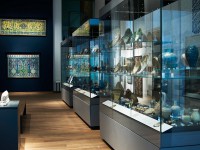Room 31 | Islamic Middle East gallery
Explore artefacts made over a period of more than 1000 years in the heart of the Islamic world.

Galleries : 1 object
Show search helpBowl with petalled decoration
-
Details
- Associated place
- Date
- 10th century (AD 901 - 1000)
- Material and technique
- earthenware, with white slip ground, and 'yellow-staining' black slip decoration
- Dimensions
-
7.2 cm (height)
25.6 cm (diameter)
- Material index
- Technique index
- Object type index
- No. of items
- 1
- Credit line
- Presented by Sir Alan Barlow, 1956.
- Accession no.
- EA1956.91
-
Further reading
Allan, James W., Islamic Ceramics, Ashmolean-Christie's Handbooks (Oxford: Ashmolean Museum, 1991), no. 6 on p. 14, illus. p. 15
Fehérvári, Géza, Islamic Pottery: A Comprehensive Study Based on the Barlow Collection (London: Faber and Faber, 1973), no. 25 on p. 55, pl. 14 b
Allan, James W., Medieval Middle Eastern Pottery (Oxford: Ashmolean Museum, 1971), p. 14, illus. p. 16 pl. 10
Watson, Oliver, Ceramics from Islamic Lands (London: Thames & Hudson, 2004)
Lane, Arthur, Early Islamic Pottery: Mesopotamia, Egypt, and Persia, Faber Monographs on Pottery and Porcelain (London: Faber and Faber, 1947), p. 18, pl. 19 b
Glossary (2)
earthenware, slip
-
earthenware
Ceramic material made of clay which is fired to a temperature of c.1000-1200⁰c. The resulting ceramic is non-vitreous and varies in colour from dark red to yellow.
-
slip
A semi-fluid clay applied to a ceramic before glazing either to coat the surface or for decorative effect.
Location
Objects are sometimes moved to a different location. Our object location data is usually updated on a monthly basis. Contact the Jameel Study Centre if you are planning to visit the museum to see a particular object on display, or would like to arrange an appointment to see an object in our reserve collections.
Galleries
Collection trails
Publications online
-

Islamic Ceramics
A slip is a semi-fluid coloured clay used either for coating an earthenware vessel or for decorating it before glazing. Here the body of the bowl is buff, and it has been covered with a white slip as a ground colour. A thick brown slip has been used for the painted design and the pot has finally been covered with a transparent yellow glaze, giving it a visually robust impact. Slip painting was very common in North-east Iran and Transoxania (the lands beyond the Oxus) in the ninth - tenth centuries, under the Samanid dynasty, and less pretentious products using the same technique are found throughout central Iran during the same period.
The design combines the Islamic taste for radial designs on ceramics, in particular stellar and cruciform patterns, with calligraphy. A cruciform ornament dominates, but as so often in Islamic pottery, a secondary cross fills out the spaces, thus completing the effect and providing the visual balance evidently desired by both craftsmen and client. The calligraphy on this bowl is difficult to recognise, but the thinly-painted filler ornament of the central circle and of each radial segment is in fact derived from kufic (geometrically-formed) Arabic script. It cannot be read, but it was probably intended to convey, symbolically, the good wishes which such inscriptions normally contained.
Notice
Objects may have since been removed or replaced from a gallery. Click into an individual object record to confirm whether or not an object is currently on display. Our object location data is usually updated on a monthly basis, so contact the Jameel Study Centre if you are planning to visit the museum to see a particular Eastern Art object.
© 2013 University of Oxford - Ashmolean Museum








